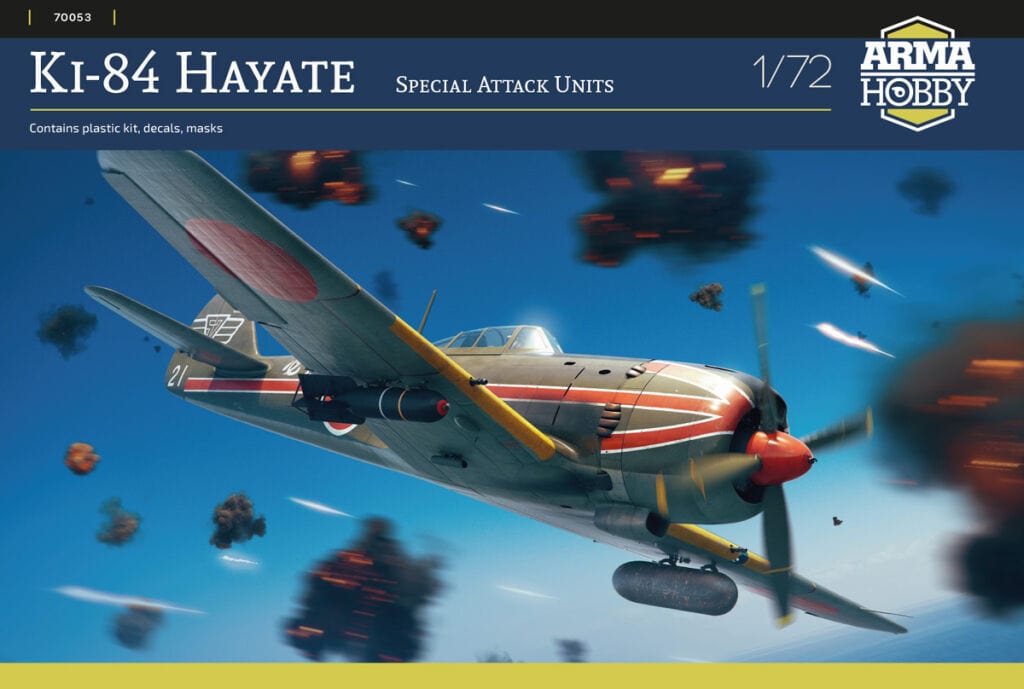This boxed set contains:
- 1 x Nakajima Ki-84 Ko Hayate ‘Frank’ 1/72 scale fighter aircraft
Imperial Japanese Army Air Service
Ki-84 Hayate plastic kit with Special Attack Squadrons markings
The set includes
Plastic parts
Canopy and wheel masks
Decals with three markings options
Markings and colours
Ki-84 Ko Hayate - 57 Shimbu-tai, pilot: Tadashi Kono, Miyakonojo airfield, Kyushu, Japan, 1945
Ki-84 Ko Hayate - 58 Shimbu-tai, pilot: Lt. Toku Ueda, Miyakonojo airfield, Kyushu, Japan 1945
Ki-84 Ko Hayate - 195 Shimbu-tai, pilot: Lt. Fujiyama Nobuho, Awaji, Yura Airfield, Japan 1945
Special Attack Squadrons, Kamikadze, and Shimbu-tai
apanese attacks, in which planes and pilots crashed into the decks of Allied ships, bring to mind the word ‘Kamikaze‘. However, the name ‘Divine Wind‘ was used only in the Naval Air Force (IJNAF) and is more popular in the Western world than in Japan. Similar formations of the Army Aviation (IJAAF) created a little later were called ‘Shinfu‘, and specific units received a number supplemented with the name ‘Shimbu-tai‘. The latter is to be understood as a “Special Attack Unit”.
Initially, the Ki-84 Hayate, which was then the Army's most modern fighter aircraft, was not intended to equip the Shimbu-tai. However, the low efficiency of attacks of older types (eg Ki-51 or Ki-27) forced a change in the approach of the Headquarters. The speed and manoeuvrability of the Hayate gave it a better chance of breaking through the cordon of American fighters and the wall of barrage ships' fire. Thus, the Hayate became one of the main participants in the fierce struggle known as the Battle of Okinawa. Several hundred machines of this type took part in it, used both for special attacks and as their escort by regular Sentai fighter units.
This boxed set contains:
-
1*Nakajima Ki-84 Ko Hayate ‘Frank’ 1/72 scale fighter aircraft
Ki-84 Hayate plastic kit with Special Attack Squadrons markings
The set includes
Plastic parts
Canopy and wheel masks
Decals with three markings options
Markings and colours
Ki-84 Ko Hayate - 57 Shimbu-tai, pilot: Tadashi Kono, Miyakonojo airfield, Kyushu, Japan, 1945
Ki-84 Ko Hayate - 58 Shimbu-tai, pilot: Lt. Toku Ueda, Miyakonojo airfield, Kyushu, Japan 1945
Ki-84 Ko Hayate - 195 Shimbu-tai, pilot: Lt. Fujiyama Nobuho, Awaji, Yura Airfield, Japan 1945
Special Attack Squadrons, Kamikadze, and Shimbu-tai
apanese attacks, in which planes and pilots crashed into the decks of Allied ships, bring to mind the word ‘Kamikaze‘. However, the name ‘Divine Wind‘ was used only in the Naval Air Force (IJNAF) and is more popular in the Western world than in Japan. Similar formations of the Army Aviation (IJAAF) created a little later were called ‘Shinfu‘, and specific units received a number supplemented with the name ‘Shimbu-tai‘. The latter is to be understood as a “Special Attack Unit”.
Initially, the Ki-84 Hayate, which was then the Army's most modern fighter aircraft, was not intended to equip the Shimbu-tai. However, the low efficiency of attacks of older types (eg Ki-51 or Ki-27) forced a change in the approach of the Headquarters. The speed and manoeuvrability of the Hayate gave it a better chance of breaking through the cordon of American fighters and the wall of barrage ships' fire. Thus, the Hayate became one of the main participants in the fierce struggle known as the Battle of Okinawa. Several hundred machines of this type took part in it, used both for special attacks and as their escort by regular Sentai fighter units.




